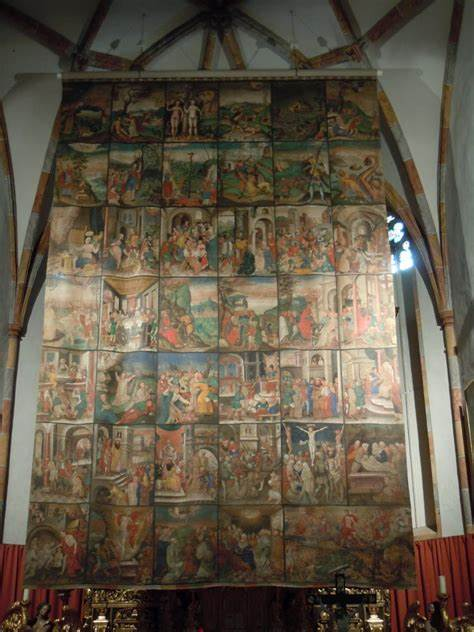Fr. Scott Haynes

Lenten Veil of the Cathedral of Fribourg (1612)
The two weeks of Passiontide begin today with this “Passion Week” being followed by “Holy Week.” On this Passion Sunday we recall the increasing tension between Christ and the Jewish leaders who would not accept Him as Messiah. They accused Jesus of sorcery and of blasphemy and being possessed by a devil. Perhaps it is easy for us to condemn in our minds those Jews who called Him a blasphemer and wanted to stone Him. But what of us? Do we heed the Word of God? Do we not mock and deride Jesus by our sinful attitudes? Do we not stone Christ by our sins and end up chasing the Word of God away? The Venerable Bede says,
“Mystically, a man throws as many stones at Jesus as he takes to himself evil thoughts; and, if he dwells on them, he then, as far as it depends on him, destroys Jesus.”

Lenten Veil of the Abbey of Millstatt in Austria (1593)
What of us? Let us put down our stones; let us put away our misdeeds and vices. Let us rather hear the Word of God with an open heart, and live virtuous lives. Let us prepare to receive the Word of God made Flesh in the Holy Eucharist by making a worthy confession. Will evil thoughts come to us? Will temptations assail us? Yes. But by God’s grace we will not consent and throw stones at our Lord. Dear friends in Christ, you are the temple of the Holy Spirit. Do not cast Jesus out of your temple.

Lenten Veil of the Cathedral of Gurk in Austria (1458)
As we enter into this week known as Passiontide, we will behold certain changes in the Liturgy which emphasize Jesus’ increasing suffering and intensifying sorrow. From today we omit the joyful Psalm 42 from the Prayers at the Foot of the Altar. If we go back to the primitive Church in Rome, we observe that catechumens came out of the baptistery chanting the joyful Psalm 42. As these newly baptized Christians emerged from the font, the Bishop confirmed them, and then, to complete their Christian initiation, went before the Altar to attend, for the very first time, the Holy Sacrifice of the Mass, and to receive their first holy Communion. As they left the Baptistery, they chanted Introibo ad Altare Dei:
“I will go unto the Altar of God.”
On Easter, when Psalm 42 returns we experience the full joy of the Risen Lord and we recall the new life of Christ we won in our baptism.
During Septuagesmia and Lent the joyous Alleluia has been hushed. Now during Passiontide, we silence the Gloria Patri (“Glory be to the Father”) prayer during the Liturgy until we celebrate Christ’s Resurrection on Easter. As we omit the Gloria Patri, we recall the words of the Prophet Isaiah:
“He was despised and rejected by men; a man of sorrows, and acquainted with grief.”

Lenten Veil of the Cathedral of Gurk in Austria, composed of 99 tableaux from Scripture (1458)
Of all the liturgical changes of Passiontide, perhaps the most striking is the covering of the crucifix and statues. Except for the Stations of the Cross, which we use to meditate upon the Jesus’ Passion, we veil most of the sacred images in church with purple cloth until Easter. The tradition of veiling statues during Passiontide is based on today’s Gospel, which tells us that in order to escape his Jewish persecutors,
“Jesus hid and went out of the temple area” (John 8:59).
The veils therefore symbolize how Christ and His apostles hid. Jesus no longer walked and taught openly among men.
The custom of veiling crosses and images has much to commend it in terms of religious psychology. The historical origin of this practice derives from an ancient custom, of extending a large cloth before the altar from the beginning of Lent.[1] This cloth, called the hungertuch (hunger cloth), hid the Altar entirely from the faithful. It was first used in Germanic countries and dates to about the year 1,000 A.D. The hunger cloth or fastentuch (fasting veil)[2] does not refer to fasting from food but has reference to visual fasting which leads us to spiritually hunger for the beauty of God and of His Temple.
The hunger cloth hid the whole sanctuary, or at least the High Altar. In Latin it was referred to as velum quadragesimale (“The Veil of the Forty Days”). In Paris, until around the year 1870, such a veil was hung from the first Sunday of Lent until the Sacred Triduum. Even more than a rood screen or an iconostasis, the velum quadragesimale hid the congregation’s view of the Sacred Liturgy. It drew inspiration from the Old Testament, where the veil of the temple shielded the Holy of Holies and the Ark of the Covenant from the gaze even of pious Jews.[3]
The hungertuch separated the faithful from the Altar, from God. Symbolically it demonstrated the effects of sin, which sunders mankind from the Beatific vision of heaven. It entailed a form of spiritual penance, a fasting of the eyes from the often brilliantly colored images of the sanctuary. However, by the twelfth century, as the ceremony of the elevation of the Host and Chalice had developed as the climax of the Mass, the veil was lifted just for that moment to allow the congregation to gaze upon Christ. At the reading of the Passion Gospel during Holy Week, the veil was dramatically parted from top to bottom at the words
“And the veil of the temple was torn from top to bottom” (Mt. 27,51; Mk. 15,38; Lk. 23,45).


Comments